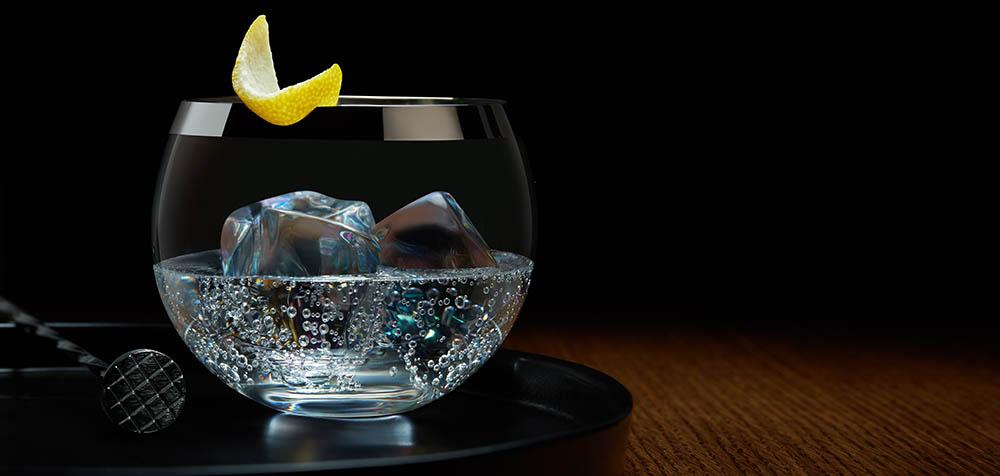As photographers, no matter what we’re photographing, we work to make sure the image has a sense of depth and our subject has shape; as we want to provide an image in the same two-dimensional form that the human eye normally sees. This is particularly true when it comes to beverage photography.
Creating smooth gradients and clean highlights provides a professional way of promoting your subject. More importantly, these techniques will help you beautifully highlight edges, create separation, and give the viewer a sense of shape and definition when viewing the image on a flat surface.
Let’s Dig In
Gradients can be defined as an increase or decrease in the amount of light that transitions from one point to another. In this case, imagine the initial point being translucent on the left side of an object and as the light transitions to white as it reaches the point on the right.
Highlights are the brightest points of an image, but in this case, a highlight will be a thin strip of light or a smooth gradient used to create definition.
There are several ways of creating gradients and highlights, but there are some methods that are more common than others. By the close of this article, you should be able to execute these methods in your own studio.
Let’s take a look at three simple methods for creating the perfect gradient and highlight to ensure your image has a more professional look.
Gear Needed
In addition to your strobe light, and in order for you to properly build attractive gradients and highlights, there are a few items you will need to properly shape and expand your light.
The strip box, complete with inner baffle and outer diffusion panel, will assist you in creating sharp edge-lines or highlights to help define shapes.

Reflectors help control the beam spread from your light source, as well as provides a harder light with more fall off. For this article, we’ll be using the 7” reflector as its most common in lighting kits.
The beauty of this diffusion paper is it helps evenly expand light across a subject and provides a cleaner gradient or highlight when properly used.

One of the many items every beverage or product photographer should have in their kit. The sole purpose of these items is to reflect a bit more light into key areas that may not be receiving enough light from your light sources.
You may see images of beverages lit from the front by two strip boxes placed on either side of the bottle to create a highlight. Is it acceptable? For some. Is it flattering? Eehhh! Does it truly promote the brand and highlight the product in its best light? I’m going to say no, and it’s not sexy.
Whether it be the curves, the labels, or fine embellishments of a product, we want to be sure we’re taking the best steps possible to promote the product. As a better approach, let’s look at three commonly used methods for lighting your products.
The Strip Box
A sharp highlight is a really beautiful way of defining the shape of a glass. In the images below, this method is used at the front side of the glass. This can also be done at the rear of the glass to hug the edges, creating a sharp outline.

Highlights coupled with shadow gradients help define the shape of glassware and bottles, giving the subject more of a two-dimensional shape and preventing it from looking flat.
Use a strip box to create a sharp highlight. Be mindful to use the inner baffle and outer diffusion panel of the strip box to ensure the line is clean and straight.
The “7 Reflector & Diffusion Paper
Creating a smooth gradient for your edge-line is easily accomplished by using diffusion paper, and a reflector on the light source.
Diffusion paper, especially the Rosco Labs 3008, is designed and treated to transmit clean, soft, evenly distributed light. The diffusion paper allows the light to be transformed into a crisp gradient on the bottle’s edge.

To create this gradient on the edge, you’ll need to enclose your subject with diffusion paper and position the light source with the 7” reflector at the rear edge of the bottle.

This will allow the light to hug the edges, creating a gradient that falls off as it wraps around toward the front of the bottle.
White Card
As you position the white card, move it toward or away from the subject to increase or decrease the intensity or width of the gradient or edge-line. Similar movements can also be used with the strip box and 7” reflector, and diffusion paper methods as described above to increase or decrease the size and intensity of your gradient or highlight.

The ability to move around your set with the white card is a bit easier, being the white card may be handheld and doesn’t assume as much space as a modified strobe light on a stand.
The key to making this work is by reflecting a good amount of light from the existing light sources lighting your set. However, this can be a bit trickier as you will be limited to the amount your sources may give off. So be prepared to really get in good and close as you work to angle your card to fill those suffering areas with light.
Your Turn!
The devil is in the details and practice makes perfect. Try these methods on different reflective surfaces. Move around your set. Work to redirect and distribute the light to other areas of your subject.
This will allow you to see the effects and add the skillset to your knowledge base. Because every beverage, glass, or bottle is not created equal, having these skills will definitely allow you to highlight and accentuate those key items and create more of a wow factor for your viewer.
Again, there are other methods for creating smooth gradients and highlights, but the three we’ve reviewed are a great starting point.

90 DAYS OF CONTENT
Over the next 90 days we are going to be working with some top artists to explore recommendations giving you solutions to problems we have all gone through. We are paying the writers a really fair wage for every original article, and we are writing about things that aren’t sponsored by any brand. There is no one but our opinion behind it. We would love it if you do use our affiliate links here so we can continue to keep writing awesome articles that you can trust.









